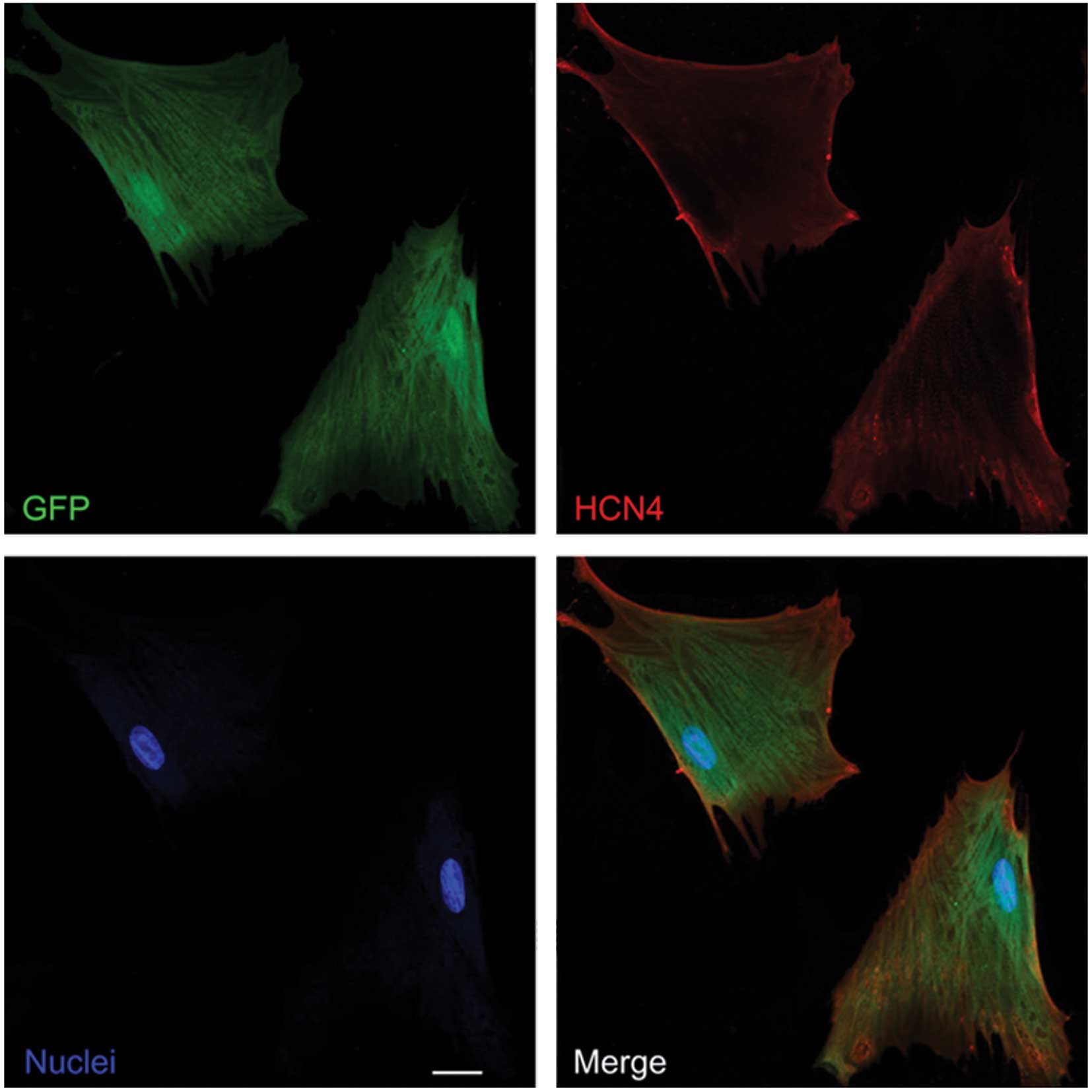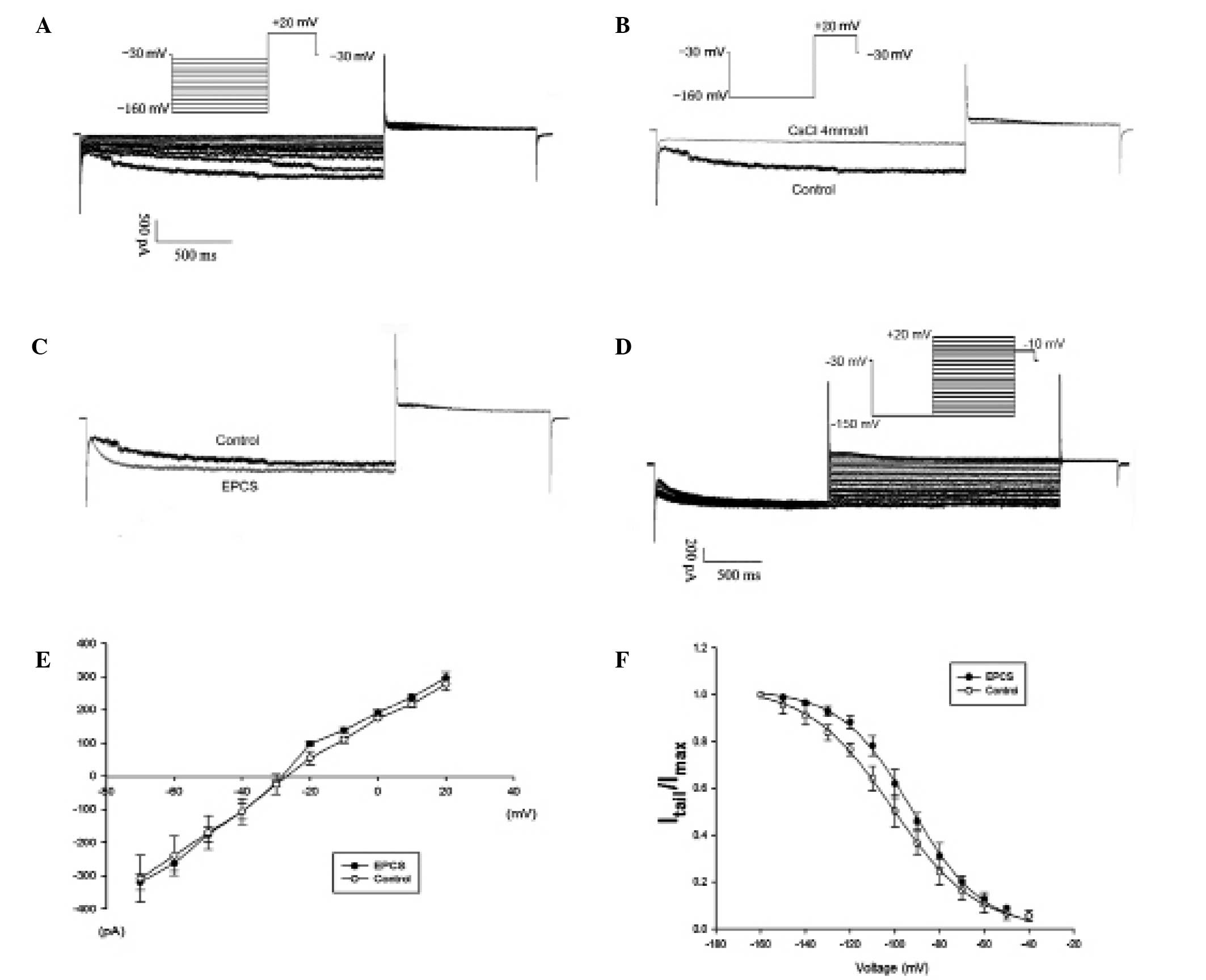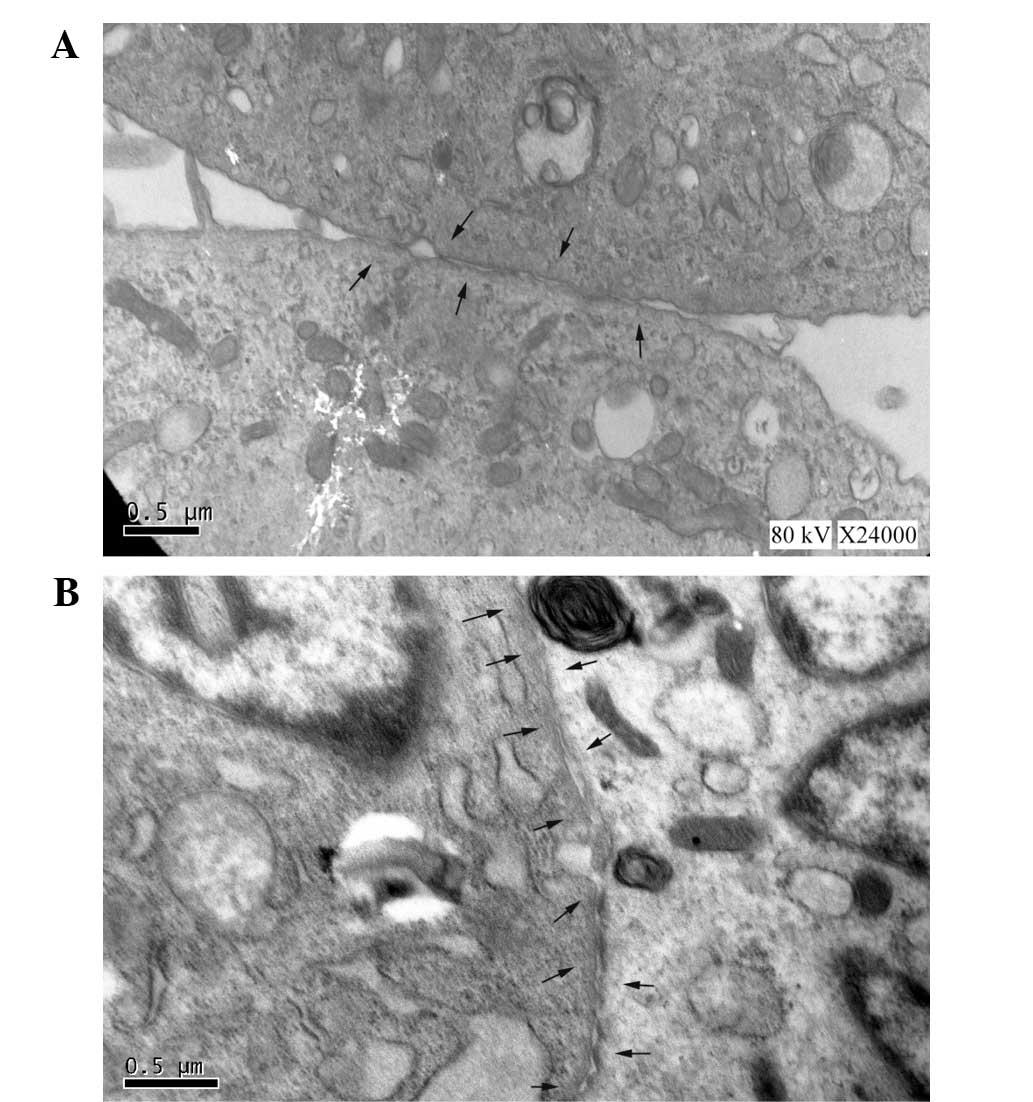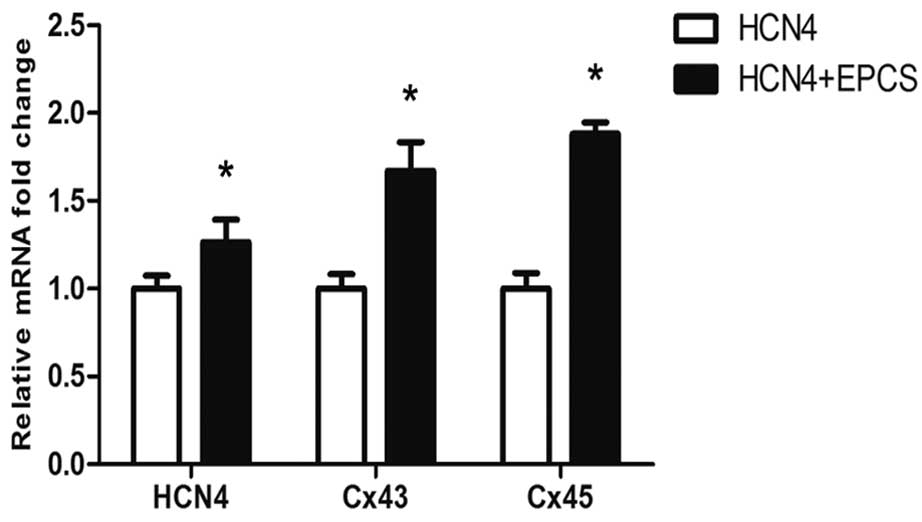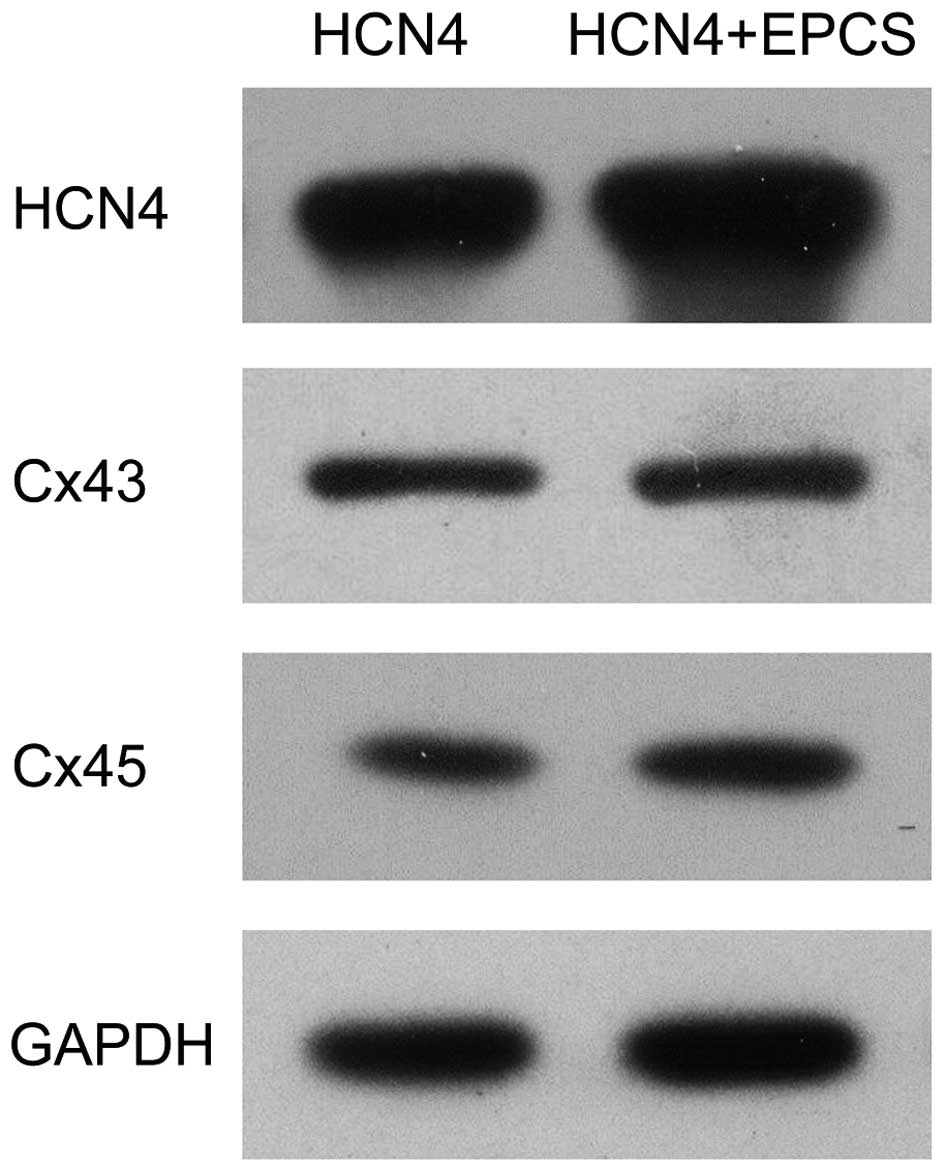|
1
|
Van Mierop LH and Gessner IH: The
morphologic development of the sinoatrial node in the mouse. Am J
Cardiol. 25:204–212. 1970. View Article : Google Scholar : PubMed/NCBI
|
|
2
|
Miake J, Marbán E and Nuss HB: Biological
pacemaker created by gene transfer. Nature. 419:132–133. 2002.
View Article : Google Scholar : PubMed/NCBI
|
|
3
|
Tong S, Yao Q, Wan Y, Zhou J, Shu M, Zhong
L, Li Y, Zhang Q, Yindai J and Song Z: Development of functional I
f channels in mMSCs after transfection with mHCN4: Effects on cell
morphology and mechanical activity in vitro. Cardiology.
112:114–121. 2009. View Article : Google Scholar : PubMed/NCBI
|
|
4
|
Nong Y, Zhang C, Wei L, Zhang Z, Cheng J,
Wen L and Song Z: In situ investigation of allografted mouse HCN4
gene-transfected rat bone marrow mesenchymal stromal cells with the
use of patch-clamp recording of ventricular slices. Cytotherapy.
15:905–919. 2013. View Article : Google Scholar : PubMed/NCBI
|
|
5
|
Jun C, Zhihui Z, Lu W, Yaoming N, Lei W,
Yao Q and Zhiyuan S: Canine bone marrow mesenchymal stromal cells
with lentiviral mHCN4 gene transfer create cardiac pacemakers.
Cytotherapy. 14:529–539. 2012. View Article : Google Scholar : PubMed/NCBI
|
|
6
|
Hart RA and Gandhi OP: Comparison of
cardiac-induced endogenous fields and power frequency induced
exogenous fields in an anatomical model of the human body. Phys Med
Biol. 43:3083–3099. 1998. View Article : Google Scholar : PubMed/NCBI
|
|
7
|
Tandon N, Cannizzaro C, Chao PH, Maidhof
R, Marsano A, Au HT, Radisic M and Vunjak-Novakovic G: Electrical
stimulation systems for cardiac tissue engineering. Nat Protoc.
4:155–173. 2009. View Article : Google Scholar : PubMed/NCBI
|
|
8
|
Radisic M, Marsano A, Maidhof R, Wang Y
and Vunjak-Novakovic G: Cardiac tissue engineering using perfusion
bioreactor systems. Nat Protoc. 3:719–738. 2008. View Article : Google Scholar : PubMed/NCBI
|
|
9
|
Radisic M, Park H, Chen F, Salazar-Lazzaro
JE, Wang Y, Dennis R, Langer R, Freed LE and Vunjak-Novakovic G:
Biomimetic approach to cardiac tissue engineering: Oxygen carriers
and channeled scaffolds. Tissue Eng. 12:2077–2091. 2006. View Article : Google Scholar : PubMed/NCBI
|
|
10
|
Wen L, Zhang C, Nong Y, Yao Q and Song Z:
Mild electrical pulse current stimulation upregulates S100A4 and
promotes cardiogenesis in MSC and cardiac myocytes coculture
monolayer. Cell Biochem Biophys. 65:43–55. 2013. View Article : Google Scholar : PubMed/NCBI
|
|
11
|
Zhao Q, Wang H, Yang M, Yang D, Zuo Y and
Wang J: Expression of a tumor-associated gene, LASS2, in the human
bladder carcinoma cell lines BIU-87, T24, EJ and EJ-M3. Exp Ther
Med. 5:942–946. 2013.PubMed/NCBI
|
|
12
|
Livak KJ and Schmittgen TD: Analysis of
relative gene expression data using real-time quantitative PCR and
the 2(-Delta Delta C(T)) Method. Methods. 25:402–408. 2001.
View Article : Google Scholar : PubMed/NCBI
|
|
13
|
Gonen-Korkmaz C, Sevin G, Gokce G, Arun
MZ, Yildirim G, Reel B, Kaymak A and Ogut D: Analysis of tumor
necrosis factor α-induced and nuclear factor κB-silenced LNCaP
prostate cancer cells by RT-qPCR. Exp Ther Med. 8:1695–1700.
2014.PubMed/NCBI
|
|
14
|
Stieber J, Herrmann S, Feil S, Löster J,
Feil R, Biel M, Hofmann F and Ludwig A: The
hyperpolarization-activated channel HCN4 is required for the
generation of pacemaker action potentials in the embryonic heart.
Proc Natl Acad Sci USA. 100:15235–15240. 2003. View Article : Google Scholar : PubMed/NCBI
|
|
15
|
Söhl G and Willecke K: Gap junctions and
the connexin protein family. Cardiovasc Res. 62:228–232. 2004.
View Article : Google Scholar : PubMed/NCBI
|
|
16
|
Kwong KF, Schuessler RB, Green KG, Laing
JG, Beyer EC, Boineau JP and Saffitz E: Differential expression of
gap junction proteins in the canine sinus node. Circ Res.
82:604–612. 1998. View Article : Google Scholar : PubMed/NCBI
|
|
17
|
Verheule S, van Kempen MJ, Postma S, Rook
MB and Jongsma HJ: Gap junctions in the rabbit sinoatrial node. Am
J Physiol Heart Circ Physiol. 280:H2103–H2115. 2001.PubMed/NCBI
|
|
18
|
Van Norstrand DW, Asimaki A, Rubinos C,
Dolmatova E, Srinivas M, Tester DJ, Saffitz JE and Duffy HS:
Connexin43 mutation causes heterogeneous gap junction loss and
sudden infant death. Circulation. 125:474–481. 2012. View Article : Google Scholar : PubMed/NCBI
|
|
19
|
Salameh A, Blanke K and Daehnert I: Role
of connexins in human congenital heart disease: The chicken and egg
problem. Front Pharmacol. 4:702013. View Article : Google Scholar : PubMed/NCBI
|
|
20
|
Yamada KA, Rogers JG, Sundset R, Steinberg
TH and Saffitz J: Up-regulation of connexin45 in heart failure. J
Cardiovasc Electrophysiol. 14:1205–1212. 2003. View Article : Google Scholar : PubMed/NCBI
|
|
21
|
Betsuyaku T, Nnebe NS, Sundset R,
Patibandla S, Krueger CM and Yamada KA: Overexpression of cardiac
connexin45 increases susceptibility to ventricular tachyarrhythmias
in vivo. Am J Physiol Heart Circ Physiol. 290:H163–H171. 2006.
View Article : Google Scholar : PubMed/NCBI
|
|
22
|
Qin Y, Zhiyuan S, Shifei T and Zewen W:
Study of differentiation of rat mesenchymal stem cells with mHCN4
gene into spontaneous cardiomyocyte-like cells in vitro. Zhong Guo
Xin Zang Qi Bo Yu Xin Dian Sheng Li Za Zhi. 21:55–58. 2007.
|
|
23
|
Valiunas V, Doronin S, Valiuniene L,
Potapova I, Zuckerman J, Walcott B, Robinson RB, Rosen MR, Brink PR
and Cohen IS: Human mesenchymal stem cells make cardiac connexins
and form functional gap junctions. J Physiol. 555:617–626. 2004.
View Article : Google Scholar : PubMed/NCBI
|















